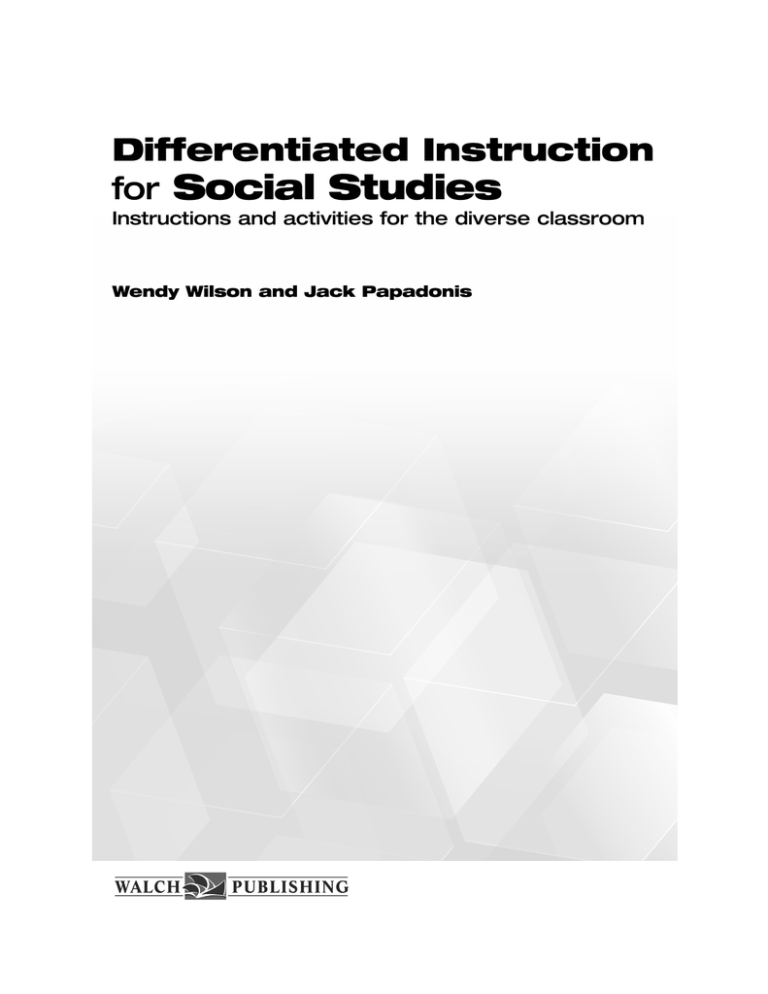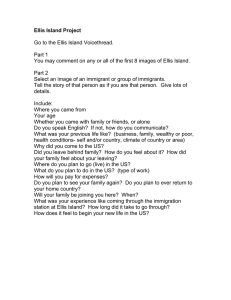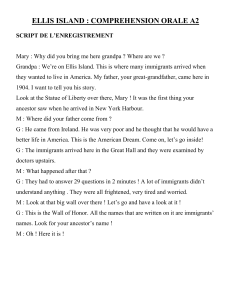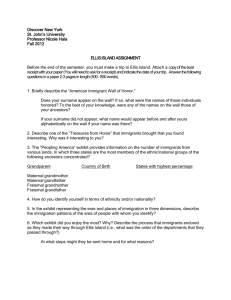Differentiated Instruction for Social Studies
advertisement

Differentiated Instruction for Social Studies Instructions and activities for the diverse classroom Wendy Wilson and Jack Papadonis Table of Contents Introduction to Differentiated Instruction . . . . . . . . . . . . . . . . . . . . . . . . . . . . . . . . . iv The Ten Themes of the Social Studies Standards . . . . . . . . . . . . . . . . . . . . . . . . . . . vii Lesson 1: A Columbian Banquet: The Great Exchange . . . . . . . . . . . . . . . . . . . . 1 Lesson 2: Creating a Children’s Book on Case Law . . . . . . . . . . . . . . . . . . . . . . . 5 Lesson 3: A Medieval Fair . . . . . . . . . . . . . . . . . . . . . . . . . . . . . . . . . . . . . . . . . . 9 Lesson 4: A Museum Display on the American West . . . . . . . . . . . . . . . . . . . . 13 Lesson 5: Join the WPA and Design a Mural . . . . . . . . . . . . . . . . . . . . . . . . . . 19 Lesson 6: A “Who Am I?” Tea Party . . . . . . . . . . . . . . . . . . . . . . . . . . . . . . . . 23 Lesson 7: History Hall of Fame . . . . . . . . . . . . . . . . . . . . . . . . . . . . . . . . . . . . . 27 Lesson 8: Stop the Presses! . . . . . . . . . . . . . . . . . . . . . . . . . . . . . . . . . . . . . . . . 35 Lesson 9: Tax Cut or Public Works Investment? . . . . . . . . . . . . . . . . . . . . . . . . 38 Lesson 10: The Powers of Congress . . . . . . . . . . . . . . . . . . . . . . . . . . . . . . . . . . 41 Lesson 11: Worse Than Slavery . . . . . . . . . . . . . . . . . . . . . . . . . . . . . . . . . . . . . 45 Lesson 12: Make Your Own Revolution . . . . . . . . . . . . . . . . . . . . . . . . . . . . . . 49 Lesson 13: Where Would You Place a Settlement? . . . . . . . . . . . . . . . . . . . . . . 54 Lesson 14: Demographic Statistics on African Nations . . . . . . . . . . . . . . . . . . . 57 Lesson 15: Points of Longitude and Latitude . . . . . . . . . . . . . . . . . . . . . . . . . . 63 Lesson 16: Creating Climographs . . . . . . . . . . . . . . . . . . . . . . . . . . . . . . . . . . . 65 Lesson 17: A Lesson in Archaeology: Build Your Baulk . . . . . . . . . . . . . . . . . . 69 Lesson 18: The Ellis Island Experience: A Simulation . . . . . . . . . . . . . . . . . . . . 72 Lesson 19: The Growth of the United States, 1865–1920 . . . . . . . . . . . . . . . . 82 Lesson 20: What Happened Here?—A Study of Genocide . . . . . . . . . . . . . . . . 86 iii Differentiated Instruction for Social Studies © 2006 Walch Publishing Introduction to Differentiated Instruction Differentiated Instruction for Social Studies provides twenty social studies lessons that cover many of the disciplines of a typical social studies curriculum such as American history, world history, geography, and civics. Many lessons can be adapted for use with several topics, and all of the lessons encompass several social studies strands and several of the multiple intelligences. The lessons are designed to provide you with models of differentiated instruction to meet the diverse learning needs of your students. Carol Ann Tomlinson in The Differentiated Classroom: Responding to the Needs of All Learners encourages educators to look at teaching and learning in a new way. Using the phrase “One size doesn’t fit all,” she presents a philosophy of educational beliefs: • Students must be seen as individuals. While students are assigned grade levels by age, they differ in their readiness to learn, their interests, and their style of learning. • These differences are significant enough to require teachers to make accommodations and differentiate by content, process, and student products. Curriculum tells us what to teach; differentiation gives us strategies to make teaching more successful. • Students learn best when connections are made between the curriculum, student interests, and students’ previous learning experiences. • Students should be given the opportunity to work in flexible groups. Different lessons point toward grouping students in different ways: individually, heterogeneously, homogeneously, in a whole group, by student interests, and so forth. • There should be ongoing assessment to help plan effective instruction. To address the diverse ways that students learn and their learning styles, we can look to Howard Gardner’s eight intelligences to provide a framework. Gardner’s theory of multiple intelligences encourages us to scrutinize our attitudes toward learning so that each student can learn in a more relaxed environment. Let’s explore what multiple intelligences look like in the social studies classroom. Visual /Spatial iv Perceives the visual world with accuracy; can transform and visualize three dimensions in a two-dimensional space. Encourage this intelligence by using graphs and making sketches, exploring spatial visualization problems, and using mapping activities. © 2006 Walch Publishing Differentiated Instruction for Social Studies Verbal/Linguistic Appreciates and understands the structure, meaning, and function of language. These students can communicate effectively in both written and verbal form. Encourage this intelligence by using class to discuss ideas, making written and oral presentations, and doing research projects. Logical/Mathematical Ability to recognize logical or numerical patterns and observe patterns in symbolic form. Enjoys problems requiring the use of deductive or inductive reasoning and is able to follow a chain of reasoning. Encourage this intelligence by organizing and analyzing data, designing and working with spreadsheets, working on critical-thinking and estimation problems, and helping students make predictions based on the analysis of numerical data. Musical/Rhythmic The ability to produce and/or appreciate rhythm and music. Students may enjoy listening to music, playing an instrument, writing music or lyrics, or moving to the rhythms associated with music. Activities related to this intelligence include using songs to illustrate skills and/or concepts. Bodily/Kinesthetic The ability to handle one’s body with skill and control, such as dancers, sports stars, and craftspeople. Students who excel in this intelligence are often hands-on learners. Activities related to this intelligence include the use of manipulatives, involvement with hands-on activities, and permitting students to participate in activities that require movement or relate physical movements to concepts. Interpersonal The ability to pick up on the feelings of others. Students who excel in this intelligence like to communicate, empathize, and socialize. Activities related to this intelligence include using cooperative-learning groups, brainstorming ideas, employing a creative use of grouping (including heterogeneous, homogeneous, self-directed, and so forth), and using long-range group projects. Intrapersonal Understanding and being in touch with one’s feelings is at the center of this intelligence. Activities related to this intelligence include encouraging students to be self-reflective and explain their reasoning, using journal questions to support metacognition, and giving students quiet time to work independently. v Differentiated Instruction for Social Studies © 2006 Walch Publishing Naturalist Naturalist intelligence deals with sensing patterns in and making connections to elements in nature. These students often like to collect, classify, or read about things from nature—rocks, fossils, butterflies, feathers, shells, and the like. Activities related to this intelligence include classifying objects based upon their commonalities, searching for patterns, and using Venn diagrams to help organize data. The Format of the Book The twenty reproducible lessons in this book have been developed to take advantage of a number of differentiation strategies. These include: • Student-centered activities, where the teacher acts as a guide to foster students’ self-reliance as learners • A variety of instructional materials • Varying approaches to assessment, including nontraditional assessment and assessment by multiple means • Flexibility in how the teacher presents the material • Flexible grouping options, with suggestions regarding activities that work best as individual projects, for pairs, and for small groups. • Flexible time to complete projects according to student levels and needs • Multiple-option assignments, where students are given a choice of ways to pursue a topic and present concepts • Multiple perspectives on ideas and events are encouraged. • Students are encouraged to problem-solve independently, to use their background knowledge, and to use their individual talents and skills • Students are encouraged to make interest-based learning choices. • Multiple intelligences are addressed in each activity, and are listed on the teacher page. You can either use these lessons as they are presented, or adapt them to your own curriculum. The curriculum standards produced by the National Council for the Social Studies have been a guide in setting up lessons that conform to the social studies standards. It is hoped that these lessons will further serve as a springboard for you to use your own ingenuity to rework lessons to meet the unique abilities of all students. vi © 2006 Walch Publishing Differentiated Instruction for Social Studies The Ten Themes of the Social Studies Standards In 1994, the National Council for the Social Studies approved a set of standards for the teaching of social studies nationwide. An integral part of this was the setting out of ten themes, or strands, that can serve as the organizing principle for classroom curriculum. Not only are these strands interrelated, but they are drawn from all of the social studies disciplines and social sciences so that they are broad and all-encompassing. The ten strands are I. CULTURE Social studies programs should include experiences that provide for the study of culture and cultural diversity. II. TIME, CONTINUITY, AND CHANGE Social studies programs should include experiences that provide for the study of the ways human beings view themselves in and over time. III. PEOPLE, PLACES, AND ENVIRONMENTS Social studies programs should include experiences that provide for the study of people, places, and environments. IV. INDIVIDUAL DEVELOPMENT AND IDENTITY Social studies programs should include experiences that provide for the study of individual development and identity. V. INDIVIDUALS, GROUPS, AND INSTITUTIONS Social studies programs should include experiences that provide for the study of interactions among individuals, groups, and institutions. vii Differentiated Instruction for Social Studies © 2006 Walch Publishing VI. POWER, AUTHORITY, AND GOVERNANCE Social studies programs should include experiences that provide for the study of how people create and change structures of power, authority, and governance. VII. PRODUCTION, DISTRIBUTION, AND CONSUMPTION Social studies programs should include experiences that provide for the study of how people organize for the production, distribution, and consumption of goods and services. VIII. SCIENCE, TECHNOLOGY, AND SOCIETY Social studies programs should include experiences that provide for the study of relationships among science, technology, and society. IX. GLOBAL CONNECTIONS Social studies programs should include experiences that provide for the study of global connections and interdependence. X. CIVIC IDEALS AND PRACTICES Social studies programs should include experiences that provide for the study of the ideals, principles, and practices of citizenship in a democratic republic. (From Expectations of Excellence: Curriculum Standards for Social Studies. Developed by the National Council for the Social Studies. Washington, D.C., 1994.) Because of the broad nature of these strands, lessons presented in this book may reflect several strands. At the beginning of each lesson, the suggested strands will be listed by number as stated on page vii and above. viii © 2006 Walch Publishing Differentiated Instruction for Social Studies The Ellis Island Experience: A Simulation OVERVIEW This lesson provides students with a simulation of the trip many immigrants to the United States and the entry at Ellis Island. The year is 1907, the busiest year in the history of Ellis Island. We chose this date because it represents a peak year in immigration to the United States. SOCIAL STUDIES STRANDS I. Culture; II. Time, Continuity, and Change; III. People, Places, and Environments; IV. Individual Development and Identity; V. Individuals, Groups, and Institutions; VI. Power, Authority, and Governance; IX. Global Connections; X. Civic Ideals and Practices DIFFERENTIATION STRATEGIES • This is a student-centered activity. The teacher is a guide to facilitate students’ self-reliance as learners. • Multiple intelligences addressed: Verbal/Linguistic, Visual/Spatial, Bodily/Kinesthetic, Interpersonal, Intrapersonal • Multiple-option assignments are used. Students are given a variety of ways to grasp the concepts in this lesson. The Ellis Island Experience: A Simulation TEACHER’S PAGE • Time can be used flexibly in accordance with student levels and needs. • Students are encouraged to use their knowledge of the subject area to present reflective responses to the task at hand in this activity. • Students’ individual creativity, talents, and skills are utilized. • Students are assessed in multiple ways. WHAT TO DO In this simulation, students will role-play immigrants as they prepare for a journey to the United States. They will experience the conditions of the sea voyage and go through the many checkpoints and inspections that immigrants faced at Ellis Island. Feel free to adapt this simulation to your own classroom and curriculum. We have provided an outline of the various stages of the simulation as well as reproducible sheets for the various forms and lists. The paperwork that most immigrants had to endure has been simplified to keep the paper and 72 © 2006 Walch Publishing Lesson 18 Differentiated Instruction for Social Studies duplication costs of this simulation at a manageable level. In some stages of the simulation, alternative activities are suggested to increase flexibility. 1. Let each student choose a role to play. We have provided a varied group of people and homelands typical of the people who might have immigrated to the United States in 1907. Included are 26 role cards, each with an immigrant’s name and country, that can be cut up. Students can then draw their role card. Ask students to locate their immigrant’s homeland on the world map (Activity 21) and draw a line from their country of origin to New York harbor. This preliminary exercise should give them an idea of the distance that they must travel. 2. Students should prepare for their trip by selecting what they will most need in their new land. Steamship companies usually allowed steerage passengers to take only one piece of luggage. You should set the limits—for example, one filled suitcase, cardboard box, or pillowcase. This luggage dilemma is an excellent discussion topic, for “family” groups or for the whole class. Students must set priorities and determine what the necessities for life will be in their new home (Activity 22). 3. Heads of families and single immigrants must fill out the necessary forms for entry into the United States. 5. When it is time to disembark, it is a good idea to have adults play the roles of the various Ellis Island inspectors and authority figures, preferably adults with whom the children are not familiar—community volunteers, or teachers or administrators from another building. The presence of strangers might help students personalize the feeling of apprehension so common to arriving immigrants. 6. As they leave the ship, immigrants must be labeled with identification tags that give the name of their ship and a number corresponding to the manifest number and line upon which their name appeared. They must also be given an inspection card (both on Activity 24) that has to be stamped by immigration officials. The exception is the immigrant from England. Lesson 18 Differentiated Instruction for Social Studies TEACHER’S PAGE The Ellis Island Experience: A Simulation 4. An adult should take the role of ship captain. The captain marks the outline of a ship with masking tape on the classroom floor. Make sure the ship is small enough to become very cramped when the immigrants and their belongings come aboard. A separate, spacious first-class cabin should be outlined to demonstrate that not all immigrants came in steerage. The ship should be named and the captain given a manifest sheet (Activity 23) that lists all of the passengers. As the immigrants board, it might be interesting to have the captain tell them that because of overcrowding, they must leave one personal item behind—this often did happen. Allow students to travel in their outline ship long enough to experience the boredom and cramped conditions. 73 © 2006 Walch Publishing He should have traveled in the first-class cabin of the ship. He should not leave the cabin. The immigration inspector should come to his cabin, ask a few questions (see below), and quickly give this immigrant an inspection card admitting him to the United States. This is what happened with passengers who were wealthy enough not to travel in steerage. This may not seem fair to students, but that is the point—it is what actually happened. 7. The other immigrants must line up and go through a series of inspections. The first inspector could call out their names one at a time and compare their tags with the manifest. The medical inspection was always one of the first at Ellis Island. Public Health Service doctors checked each immigrant for signs of physical or mental illness. If a problem was suspected, the immigrant was marked with a piece of chalk—such things as the letter H for a suspected heart problem, L for lameness, X for mental defects. This could be a sensitive process for some classrooms; you may prefer to have the inspector do an overall check and scribble something on a notepad. Or, the official could draw a nonsense symbol with a piece of chalk. By not explaining the meaning of the symbol, the official can help replicate the bewilderment that immigrants felt during processing. Finally, an inspector should ask each immigrant a series of rapid-fire questions to determine the person’s fitness to remain: 1. What is your name? (The inspector should write a few names incorrectly or simplify a few. Many immigrants had their names Americanized during the inspection process whether they wished it or not.) 2. How old are you? The Ellis Island Experience: A Simulation TEACHER’S PAGE 3. Where were you born? 4. Are you married or single? 5. What work do you do? 6. Do you have a job waiting for you here? (A trick question, because to answer “yes” meant you were violating the Contract Labor Law of 1885. It was illegal for immigrants to take a job in the United States before they left home in order to pay for their passage.) 7. Who paid for your passage here? 8. Is anyone meeting you here? 9. Where are you going? 10. Can you read and write? 11. Have you ever been in prison? 74 © 2006 Walch Publishing Lesson 18 Differentiated Instruction for Social Studies 12. How much money do you have? 13. Show it to me. 14. Where did you get it? 15. Have you ever been deported? If the immigrant answers these questions satisfactorily, the inspector enters the immigrant’s name on the inspection card and stamps it for approval. In reality, there were interpreters for the many immigrants who did not speak English. To simulate the language barrier, ask the inspector to express difficulty in understanding the immigrant and to repeat the question several times. To further replicate the immigrant experience, you could detain a few immigrants for further questioning or even have some deported. Single females were not allowed to enter the United States unless someone (a relative, fiancé, or representative from an Immigrant Aid Society) was going to come for her. Immigration officials would not allow a single woman to leave alone. Once processed, the immigrants hand in their inspection cards to a final inspector who should check it one last time and then issue landing cards. Now the immigrants are free to enter the United States legally. VARIATIONS Here are a few ways in which you might end this simulation: • Have a “Welcome to America” party featuring the foods from the immigrants’ native lands. • Have a Fourth of July party (no matter what time of year) where the immigrants can talk about what it means to be an American. • Make a leap into the future by asking the immigrants what has happened to them since they came here. Do they wish to become U.S. citizens? Why or why not? (Remember, as many as one third of all immigrants who entered the United States emigrated back to their homelands or to another country.) A simulated naturalization ceremony could be held for those immigrants who wish to become citizens. Lesson 18 Differentiated Instruction for Social Studies TEACHER’S PAGE The Ellis Island Experience: A Simulation • Have the students share their feelings, either in writing or orally, about going through the Ellis Island experience. 75 © 2006 Walch Publishing Here are some additional activities to do with your class: 1. Have students construct passports issued by their homeland. Every person entering this country had to have a passport from his or her country of origin. This would be a good research activity to discover each country’s flag, seal, and so forth. 2. During the shipboard journey, pass around a bowl of unseasoned cooked cereal and plastic spoons. Students can try this dish to simulate the kind of food served to steerage passengers. 3. If your students know or are studying a foreign language, this might be an opportunity for them to use it. Most immigrants coming to this country did not speak English. 4. If some students do not feel comfortable role-playing the part of an immigrant, they could act as immigrant-aid officials. Many nationalities had officials in the United States who would act in immigrants’ interest, helping them find housing and jobs. Representatives of these organizations could be at Ellis Island watching out for immigrants of their national background. The Ellis Island Experience: A Simulation TEACHER’S PAGE 5. The special treatment afforded the immigrant from England could be a good topic for class discussion. Why did he receive preferential treatment? Was it his level of education? his economic status? his lack of a language barrier? 76 © 2006 Walch Publishing Lesson 18 Differentiated Instruction for Social Studies IMMIGRANT ROLE CARDS Wilhelm Ackermann Two-year-old child Erfurt, Germany Jano Milosevic Single male Occupation: herder Visegrad, Siberia Maria Kozlowski Mother of family of three Bydgoszcz, Poland Domenic Masiello Single male Occupation: leather worker Salerno, Italy Helga Ackermann Eight-year-old child Erfurt, Germany Cecile St. Pierre Married female Guadeloupe, French West Indies Caterina Kozlowski Twelve-year-old child Bydgoszcz, Poland Rachel Issacshon Mother of family of two Kiev, Russia Stenka Kozlowski Five-year-old child Bydgoszcz, Poland Jean St. Pierre Married male Occupation: laborer Guadeloupe, French West Indies Ara Karagosian Single male Occupation: merchant Yerevan, Armenia, Ottoman Empire Wilhelmina Ackermann Mother of family of four Erfurt, Germany Frederich Ackermann Father of family of four Occupation: farmer Erfurt, Germany Michael McCrory Single male Occupation: shipyard worker Belfast, Ireland Stefan Kozlowski Father of family of three Occupation: farmer Bydgoszcz, Poland Johanna Ackermann Five-year-old child Erfurt, Germany Olé Johannson Single male Occupation: farmworker Byglandsfjord, Norway First-class passenger James Smythe-Jones Single male Recent university graduate Manchester, England Elise Ackermann Six-year-old child Erfurt, Germany Joshua Issacshon Twelve-year-old child Kiev, Russia Mariush Kozlowski Ten-year-old child Bydgoszcz, Poland Jacob Issacshon Father of family of two Occupation: tailor Kiev, Russia Antonio Angellino Single male Occupation: laborer Naples, Italy Spiros Zoutsoghianopoulos Single male Occupation: stonecutter Agrinion, Greece Rebecca Issacshon Fourteen-year-old child Kiev, Russia Lesson 18 Differentiated Instruction for Social Studies TEACHER’S PAGE The Ellis Island Experience: A Simulation Brigid O’Connor Single female Occupation: domestic worker Galway, Ireland 77 © 2006 Walch Publishing The Ellis Island Experience: A Simulation WORLD MAP Activity 21: The Ellis Island Experience: A Simulation Directions: On the map, draw a line between the country your character is from and New York harbor. 78 © 2006 Walch Publishing Lesson 18 Differentiated Instruction for Social Studies The Ellis Island Experience: A Simulation WHAT WILL YOU BRING? Directions: Working either individually or in your “family” group, according to your role, you must decide what to bring with you to America. Most immigrants traveled in third class, or “steerage” class, and there was little space for luggage. You are allowed one piece of luggage only. What will you need? Think about what is most important to you. Families often brought a cooking pot to prepare their meals. Are there any mementos of your homeland you wish to keep? If you are a skilled worker, do you wish to bring your tools to help you get a job in your new home? List the things you wish to bring in the order of their importance in case you are asked to lighten the load and leave something out at the last minute. Possession Reasons I (or my family) will need this ______________________________________________________________ ______________________________________________________________ ______________________________________________________________ ______________________________________________________________ ______________________________________________________________ ______________________________________________________________ ______________________________________________________________ ______________________________________________________________ ______________________________________________________________ ______________________________________________________________ ______________________________________________________________ Activity 22: The Ellis Island Experience: A Simulation ______________________________________________________________ 79 Lesson 18 Differentiated Instruction for Social Studies © 2006 Walch Publishing The Ellis Island Experience: A Simulation SHIP’S MANIFEST Ship’s Name ____________________________________________________ Date ____________________ Home Port ____________________________ No. Passenger Class Country of Origin Occupation 01 02 03 04 05 06 07 08 09 Activity 23: The Ellis Island Experience: A Simulation 10 11 12 13 14 15 16 17 18 19 20 21 22 23 24 25 26 80 © 2006 Walch Publishing Lesson 18 Differentiated Instruction for Social Studies The Ellis Island Experience: A Simulation IDENTIFICATION TAG AND INSPECTION CARD ---------------------------------------------------------------------------------------------Ship’s Name ____________________________________________ Date __________________________________________________ Manifest Number ________________________________________ Line Number ___________________________________________ ---------------------------------------------------------------------------------------------Number ___________ INSPECTION CARD (Immigrants and Steerage Passengers) Name of Ship ________________________ Date of Arrival ______________ Name of Immigrant ______________________________________________ Last Residence __________________________________________________ Issued and Passed at Stamp: Passed by Immigration Bureau Port of _____________ Date ___________ ---------------------------------------------------------------------------------------------(The following to be filled in by ship personnel prior to ship embarkation) Ship Manifest Number ____________________ Line on Manifest __________ ______________________________________________________________ Activity 24: The Ellis Island Experience: A Simulation Port of Departure ___________________ Date of Departure ______________ 81 Lesson 18 Differentiated Instruction for Social Studies © 2006 Walch Publishing





